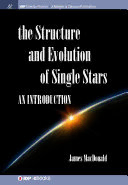
Stellar Structure and Evolution PDF
Preview Stellar Structure and Evolution
Astronomy and Astrophysics Library Rudolf Kippenhahn Alfred Weigert Achim Weiss Stellar Structure and Evolution Second Edition 123 ASTRONOMY AND ASTROPHYSICS LIBRARY SeriesEditors: G.Bo¨rner,Garching,Germany A.Burkert,Mu¨nchen,Germany W.B.Burton,Charlottesville,VA,USAand Leiden,TheNetherlands A.Coustenis,Meudon,France M.A.Dopita,Canberra,Australia B.Leibundgut,Garching,Germany A.Maeder,Sauverny,Switzerland P.Schneider,Bonn,Germany V.Trimble,CollegePark,MD,andIrvine,CA,USA Forfurthervolumes: http://www.springer.com/series/848 • Rudolf Kippenhahn Alfred Weigert Achim Weiss Stellar Structure and Evolution Second Edition 123 RudolfKippenhahn AchimWeiss Go¨ttingen Max-Planck-Institutfu¨rAstrophysik Germany Garching Germany AlfredWeigert Universita¨tHamburg Hamburg Germany ISSN0941-7834 ISBN978-3-642-30255-8 ISBN978-3-642-30304-3(eBook) DOI10.1007/978-3-642-30304-3 SpringerHeidelbergNewYorkDordrechtLondon LibraryofCongressControlNumber:2012950870 (cid:2)c Springer-VerlagBerlinHeidelberg2012 Thisworkissubjecttocopyright.AllrightsarereservedbythePublisher,whetherthewholeorpartof thematerialisconcerned,specificallytherightsoftranslation,reprinting,reuseofillustrations,recitation, broadcasting,reproductiononmicrofilmsorinanyotherphysicalway,andtransmissionorinformation storageandretrieval,electronicadaptation,computersoftware,orbysimilarordissimilarmethodology nowknownorhereafterdeveloped.Exemptedfromthislegalreservationarebriefexcerptsinconnection with reviews or scholarly analysis or material supplied specifically for the purpose of being entered and executed on a computer system, for exclusive use by the purchaser of the work. Duplication of this publication or parts thereof is permitted only under the provisions of the Copyright Law of the Publisher’slocation,initscurrentversion,andpermissionforusemustalwaysbeobtainedfromSpringer. PermissionsforusemaybeobtainedthroughRightsLinkattheCopyrightClearanceCenter.Violations areliabletoprosecutionundertherespectiveCopyrightLaw. Theuseofgeneraldescriptivenames,registerednames,trademarks,servicemarks,etc.inthispublication doesnotimply,evenintheabsenceofaspecificstatement,thatsuchnamesareexemptfromtherelevant protectivelawsandregulationsandthereforefreeforgeneraluse. While the advice and information in this book are believed to be true and accurate at the date of publication,neithertheauthorsnortheeditorsnorthepublishercanacceptanylegalresponsibilityfor anyerrorsoromissionsthatmaybemade.Thepublishermakesnowarranty,expressorimplied,with respecttothematerialcontainedherein. Printedonacid-freepaper SpringerispartofSpringerScience+BusinessMedia(www.springer.com) To OurWives • Preface to the First Edition Theattemptto understandthephysicsofthe structureofstarsandtheir changein time – their evolution– hasbeen botheringmanyphysicistsandastronomersever since the last century. This long chain of successful research is well documented notonlybynumerouspapersin the correspondingjournalsbutalso bya seriesof books.Someofthemaresoexcellentlywrittenthatdespitetheiragetheycanstill be recommended and not only as documents of the state of the art at that time. A few outstanding examples are the books of Emden (1907), Eddington (1926), Chandrasekhar (1939), and Schwarzschild (1958). But our science has rapidly expandedin the last few decades,and newaspects haveemergedwhichcouldnot evenbeanticipated,say,30yearsagoandwhichtodayhavetobecarefullyexplored. Thisdoesnotmean,however,thatourambitionistopresentacompleteaccount of the latest and most refined numericalresults. This can well be left to the large and growing number of excellent review articles. This book is intended rather to beatextbookthatwillhelpstudentsandteacherstounderstandtheseresultsasfar aspossibleandpresenttheminasimpleandclearmanner.We knowhowdifficult this is since we ourselveshave tried for the largest part of our scientific career to understand “how the stars work” – and then to make others believe it. In these attempts we have found that often enough a simplified analytical example can be morehelpfulthan the discussion of an exceptionallybeautifulnumericalsolution. Thereforewedonothesitatetoincludemanysimpleconsiderationsandestimates,if necessary,evenattheexpenseofrigourandthelatestresults.Thereadershouldalso notethatthelistofreferencesgiveninthisbookisnotintendedtorepresentatable ofhonourforthe(knownandunknown)heroesofthetheoryofstellarstructure;itis merelydesignedtohelpthebeginnertofindafewfirstpathsintheliteraturejungle and presents those papers from which we have more or less randomly chosen the numbersforfiguresandnumericalexamples(Thereareothersofatleastthesame quality!). The choice of topics for a book such as this is difficult and certainly subject to personal preferences. Completeness is neither possible nor desirable. Still, one may wonder why we did not include, for example, binary stars, although we are obviouslyinterestedintheirevolution.Thereasonisthathereonewouldhavehad vii viii PrefacetotheFirstEdition to include the physics of essentially non-spherical objects (such as disks), while weconcentratemainlyonsphericalconfigurations;eveninthebriefdescriptionof rotationtheemphasisisonsmalldeviationsfromsphericalsymmetry. This book would never have been completed without the kind and competent help of many friends and colleagues. We mention particularly Wolfgang Duschl and Peter Schneider who read critically through the whole manuscript; Norman Baker, Gerhard Bo¨rner, Mounib El Eid, Wolfgang Hillebrandt, Helmuth Kahler, Ewald Mu¨ller, Henk Spruit, Joachim Wambsganß, and many othersreadthroughparticularchaptersandgaveustheirvaluableadvice.Infactit would probablybe simpler to give a complete list of those of our colleagueswho havenotcontributedthanofthosewhohelpedus. Inadditionwehavetothankmanysecretariesatourinstitutes;severalhaveleft their jobs (for other reasons!) during the five years in which we kept them busy. Most of this work was done by Cornelia Rickl and Petra Berkemeyer in Munich andChrista LeppienandHeinke Heise in Hamburg,while Gisela Wimmersberger preparedallthegraphs.Wearegratefultothemall. FinallywewishtothankSpringer-Verlagfortheirenthusiasticcooperation. MunichandHamburg RudolfKippenhahn December1989 AlfredWeigert Preface to the Second Edition Twenty years after its first publication, this textbook is still a major reference for scientistsandstudentsinterestedinorworkingonproblemsofstellarstructureand evolution.Butwiththeincrediblegrowthofcomputationalpower,thecomputation ofstellarmodelshastolargeextentbecomeastandardtoolforastrophysics.While theearlycomputationswererestrictedtosinglechoicesformass,compositionsand possiblyevolutionarystage,bynowmodelsforthewholeparameterspaceexist.The firsteditionofthisbookwasrestrictedtoafewexamplesforlow-andintermediate- massstarevolutionandlackedthebroaderviewnowbeingpossible.Thereareeven semi-automaticstellarevolutioncodesthatmaybeusedremotelyviatheInternet. However, stellar evolution programs should not be used without a thorough understanding of the stellar physics. Therefore, a textbook concentrating on the foundationsofthetheoryandexplainingindetailspecificphasesandeventsinthe life of a star is very much needed to allow scientifically solid modelling of stars. Thisisthereasonwhythisbookdeservedasecondedition. Much to our regret, A. Weigert passed away two years after publication of the firstedition.Heleftagapthatcannotbefilled.Giventheabovementionedneedfor asecondeditionandtherequirementtoaddup-to-datestellarmodels,itwasdecided tohaveA.WeissjoinR.Kippenhahninpreparingthenewedition. The two authors of this book came to discriminate between the eternal truth and the mutable parts. The latter ones refer to the current state of modelling and knowledgeobtainedfromnumericalmodelsandtheircomparisontoobservations. Such chapters were updated, extended, or added. As far as possible, the stellar modelsshownwerespecificallycalculatedforthispurpose,withthepresent,much evolvedversionoftheoriginalcodebyKippenhahn,Weigert,andHofmeister.The numericalresultsarethereforemuchmorehomogeneousandconsistentthaninthe firstedition. The eternal truth concerns the aforementioned basic physics and their under- standing.Thesepartsofthebookhavebeenleftalmostuntouched,sincetheauthors (andthosereaderswhowereconsulted)didnotseeanyreasontochangethem. Theauthorsareindebtedtomanyfriendsandcolleagueswhogavetheiradvice or comments, with respect to both necessary changes and the new text passages. ix
